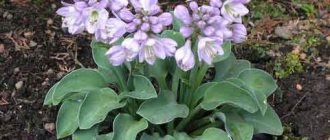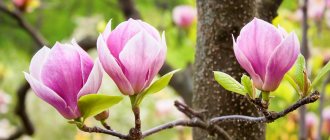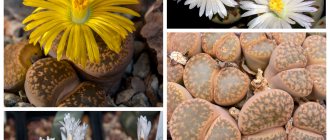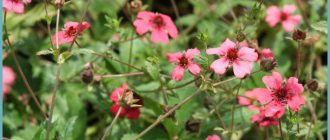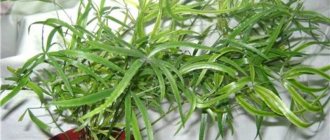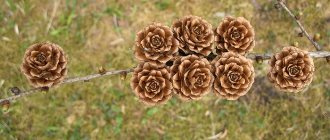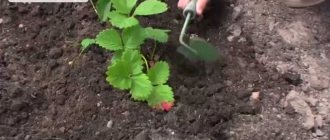Description, reproduction and distribution area of the common barberry
A thorny and deciduous shrub from the barberry family, the plant height does not exceed three meters.
The shrub is highly branched and has a strong superficial root system. Old branches of the plant have gray bark, but the bark of young branches is yellow-brown or yellowish-gray.
The branches of barberry are thin, sometimes with simple spines, and you can find a barberry bush with tripartite spines (there are buds in their axils). Small branches with leaves emerge from the buds.
The leaves of the plant are oblong in shape, with spiny cilia located on the edges of the leaves.
Barberry flowers emit a strong aroma, the color of the flowers is light yellow. Flowers numbering 15–25 are collected in drooping axillary racemes.
The barberry fruit is a dark red berry. The berry is very juicy and has several seeds. The weight of the barberry fruit does not exceed 4 grams.
The seeds are dark brown in color, have a flattened shape, and fine wrinkles.
Barberry flowering begins in May and lasts until June. Fruit ripening occurs between July and October.
Distributed in the southern regions of our country, in the middle zone it is grown as an ornamental plant. Loves dry sunny areas.
Video: how to sow barberry seeds
Barberry is unpretentious in care, but for good growth and fruiting it is necessary to carry out a number of mandatory measures:
- Watering. The plant is highly drought-resistant, but there should be enough moisture during planting and during the rooting period. Watering an adult bush is carried out when the soil dries out significantly.
- Loosening is an important condition for good plant growth. The root system needs free access to moisture and oxygen.
- Weed removal is carried out at the time of loosening.
- Mulching is carried out to preserve moisture. For this, peat or sawdust is used.
- Feeding is carried out in the second year after planting. In spring, it is recommended to water with a solution of mullein or chicken droppings. During the flowering period, the shrub is fertilized with granular complex fertilizers. In September, under each bush you need to add:
- potash fertilizers - 10 grams;
- superphosphate—15 grams.
Planting a single plant
How to grow feijoa from seeds at home
To plant a single plant purchased in a store, you need to choose a place no closer than two or three meters from other plants. You need to dig a hole larger than the earthen ball of the plant itself.
Planting pit
It is advisable to prepare a nutritional composition from turf soil, peat, humus, taken in a ratio of 2:1:1. Water the seedling well and carefully remove it from the container, being careful not to damage the root system.
Place the bush in the hole
Fill the soil, compact it
Water thoroughly
Add soil and water again
Carefully examine the plant; if you notice damage or rotting of the roots, remove this area. If there are no special preparations, treat the cut area with a solution of potassium permanganate and dust with activated carbon.
After planting, water the barberry well and if the weather is very hot and dry, make a small shelter. After the plant has taken root, the shelter must be removed. Seedlings purchased in containers take root faster and better.
barberry bush
If you need to plant a seedling with an open root system, straighten the roots well in the hole, this will speed up the establishment of the plant. Such a seedling will require more attention, and its rooting time will be longer.
How barberry propagates - basic methods
Although you rarely see barberry in domestic gardens, its propagation is not as difficult as it might seem. Using layering, cuttings or seeds, you can independently grow a dense hedge of barberry or decorate your area with individual ornamental bushes.
However, choosing the right option can be difficult, since each has its own disadvantages:
Photo of barberry
- rooting of cuttings occurs quite slowly;
- the germination rate of barberry seeds ranges from 20% to 40%, and the varietal characteristics of the new plant may not be preserved;
- when dividing a bush, there is a high risk of significantly damaging the root system;
- Not all types and varieties of barberry produce root shoots.
Try experimenting with different methods to determine which one is most suitable for your barberry variety and is convenient for you. For example, propagation of Thunberg barberry by cuttings is best done, because it produces many thin young shoots that can become excellent planting material. But for Monetchaty it is worth choosing another method, for example, propagating barberry by seeds - its cuttings take root with great difficulty.
Pros and cons of different methods of propagating shrubs
How to grow magnolia from seeds at home
Barberry is a fast-growing shrub with a strong and branched root system. It is unpretentious to the soil, drought-resistant, plastic, grows in the sun and in the shade. Having just one bush, in a couple of years you can grow a lot of excellent planting material, exchange varieties with other lovers, and create spectacular compositions.
Let's consider the advantages and disadvantages of the available methods of propagating decorative barberry.
- The simplest method with 100% root formation is planting root suckers and layering. But if horizontal layering completely duplicates varietal characteristics, then with root shoots not everything is so simple. A variety grafted onto a seedling “drives” wild animals as offspring. In addition, not all cultivated forms of barberry produce shoots.
- Propagation by seeds makes it possible to obtain many seedlings without much labor effort. But it should be remembered that shrub seeds have a low germination rate (up to 40%), do not have genetic memory, and, therefore, do not retain the characteristics of the variety. In addition, you need to be patient - you will have to wait at least 2 years until the seedling gets stronger before replanting it in a permanent place.
- An effective technique is barberry cuttings, which can be done in spring, summer and autumn. Summer cuttings are green and take root better. Woody material is harvested after leaf fall or cut in early spring before buds open. The advantages of this method are the preservation of grade, you can immediately get a lot of seedlings, rapid growth after rooting. This is the most labor-intensive method, not everyone succeeds, you need, as they say, “to get better at it.”
- Another simple option for propagating barberry is dividing one bush into 2-3 parts. Among the disadvantages is a small, but still risk that the plants will not tolerate transplantation well. In addition, if the shrub is grown in the form of a tree or the branching goes above the soil level, this method is not suitable.
Popular varieties, their use in landscape design
The “Catalogue of Ornamental Trees and Shrubs, Union of Polish Nurseries” describes 21 varieties of Barberry Thunberg as the most popular representatives of sales. The largest among them are:
- “ Kelleriis ” - up to 3 m high. The leaves are covered with small white specks. From a distance it seems to be blooming.
- “ Kornik ” - 1.5 - 2 m in size. The leaves are white-green with a pattern reminiscent of marble.
- “ Golden Ring ” - with bright red leaves and a yellow border along the edge.
- “ Harlequin ” – cherry-colored leaves with paler spots.
All of these varieties are unpretentious to the soil and tolerate urban conditions and frosts well.
Low growing varieties:
- “ Bagatelle ” – up to 40 cm in diameter when mature. The color of the leaves is brownish-red.
- “ Aurea ” – shrub height, on average 1 – 1.2 m. Leaves are golden, flowers are white.
- “ Green Carpet ” - can reach 1 m in height, but if there is space, it grows up to 1.5 m wide. The leaves are emerald green in color.
Columnar-shaped hybrid forms are interesting:
- “Powwow”
- "Maria"
- "Helmond Pilar"
These and many other varieties are successfully used in landscape design, as single tapeworms, in a group with other trees and shrubs. Recently, forms of Barberry with colored leaves have been successfully included in flower beds. Most varieties tolerate pruning well, which is why hedges made from them are a very popular technique.
Modern varieties of Barberry Thunberg allow you to create hedges from several hybrid forms.
Rules for planting a new garden resident
How to grow orchids from Chinese seeds at home
Now is the time to talk about how to properly plant such an amazing plant. Most often this is done in the spring, but this procedure can also be carried out in the fall. It was already mentioned earlier that the bush is unpretentious, but you still have to adhere to some rules.
It is very important to choose the right site. In principle, the shrub grows both in the sun and in shaded places, but if you want to please the eye with gorgeous greenery, it is better to give preference to a more illuminated area
In addition, in the shade this representative of the flora stops bearing fruit. Avoid areas with close groundwater. Light soils or loams are excellent, as long as there is no stagnant moisture
Pay attention to acidity; if it exceeds 7 pH, then the soil should be limed. Moreover, this procedure can be carried out directly during landing.
To do this, add a mixture of peat, humus, turf soil, wood ash (200 g) and slaked lime (400 g) to the hole.
Growing fruiting barberry
The distance at which you place the bushes largely depends on the purpose. For example, if you plan to plant a single specimen, then it is necessary that there is no vegetation within a radius of at least 1.5 m. But when you use the plant as a hedge, the bushes are planted every 50 cm.
The holes must be prepared 14–21 days before planting. For one shrub, a hole measuring 40x40 cm is dug; in the case of a hedge, a trench of the same depth should be prepared. Next, fill the bottom with sand. This will have the most positive effect on the aeration of the root system. Now you need to place the seedling in the hole and cover its lower part with soil. We compact the soil well and act carefully, otherwise you will damage the roots, which will negatively affect the future condition of the plant. Now all that remains is to water the new resident generously and mulch with peat or compost. At the end of the process, the upper part of the seedling is cut off so that 3 or maximum 5 well-developed buds remain.
Rooting barberry
If you are interested in information about how barberry reproduces, then it is worth considering one more method - planting with root shoots.
This method has a number of limitations, since old, well-grown barberry is suitable for it. Young bushes do not form shoots. Only after a couple of years do buds begin to form on the roots of the plant, from which new shoots sprout.
We recommend that you read: Sheltering gooseberries for the winter
Since the shoots appear not in the center of the rhizome, but along its periphery, you need to go around the bush and carefully examine the soil. If you find new young branches sticking out of the ground next to the mother plant, then you need to carefully dig them up with a shovel.
The place where the roots of the shoot connect to the large rhizome of the mother barberry must be carefully cut with pruning shears. Now the branch can be transplanted to a suitable place, watered and wait until the plant finally takes root.
Barberry can be rooted by layering. This method is used less frequently. The breeding scheme is as follows:
- An adult mother bush that has already produced shoots is suitable for this method. It is better to carry out the procedure in the spring, after the snow has melted and the soil has had time to warm up well. You need to find a one-year-old shoot, which will become a layer.
- A small furrow is dug next to the bush - a depth of 5-10 cm will be enough.
- The selected shoot must be carefully bent and placed in the trench so as not to break or damage it.
- In order for the branch to remain underground, it is better to secure it with hooks or staples at the top and at the base. But the top of the shoot should remain outside, above the soil surface. Only later can it be pruned in order to stop further growth of the branch in length - this way you will have a better chance of rooting the plant.
- The shoot is covered with soil. You can put some kind of weight on top (for example, a brick) to fix the layer in the desired position.
- Afterwards, the plant must be thoroughly watered and covered with dry leaves or grass.
- In summer, do not forget to regularly water the shoot and make sure that the soil does not dry out - the plant will grow its first roots faster.
- In the fall or next spring, rooted plants can be separated from the mother bush and replanted.
Barberry can be propagated in different ways. But it is worth understanding that only vegetative methods (by dividing an adult plant) will result in a new bush that matches the characteristics of the mother plants.
All varieties of barberry can be propagated using the methods described above, but the plants still have their own preferences. For example, Thunberg barberry tolerates cuttings well, and layering takes root less often. And it is better to propagate coin barberry through seeds.
Methods for propagating barberry
Seeds
The photo shows barberry seeds
The easiest and most affordable way. Collect well-ripened berries and remove the seeds. Rinse in warm water or a weak solution of potassium permanganate. If seeds are planted in the fall, they can be treated with growth regulators. If you plan to sow in spring, the seeds should be kept in a cool place (perhaps on the bottom shelf of the refrigerator).
Barberry from seeds
For planting, the soil is dug up directly in the garden, and the seeds are sown in rows. The seeds have a low germination rate. Statistically, no more than three out of 10 seeds will sprout, so don’t be afraid to thicken the plantings. Autumn seeds will sprout in spring. Seedlings need to be given time to grow well and become stronger. In one and a half, two years they will make good planting material.
Cuttings
Barberry propagation technique
For cuttings, choose healthy annual branches, the lower part of which is already woody. Cut into sizes from 10 to 15 cm. The bottom cut should be made at an angle. Select branches with 3-4 internodes.
Barberry cuttings
Prepared cuttings are soaked in a growth accelerator and phytohormones are used.
Cuttings in a jar
Planted in a mixture of sand (1 part) and peat (2 parts). Rooting occurs at home or in a greenhouse. Plantings must be covered. Cuttings require constant monitoring. They are ventilated, watered and sprayed with water if necessary, and the soil is constantly loosened. A sign that the cuttings have taken root will be the appearance of new leaves. Now the cuttings are hardened off and prepared for transplanting to a permanent location.
Photo of barberry cuttings in a pot
Barberry: propagation by cuttings
Layerings
Scheme of barberry propagation by offsets
Reproduction by layering is a method accessible even to beginners. Choose a bush that is suitable for propagation. Clean and loosen the tree trunk circle. They find annual, well-woody branches. Small trenches are dug in the direction of growth of these branches. Selected branches are placed in them and pinned (you can use wire bent in half).
Reproduction by layering
The whole procedure is done in the spring. During the summer, water and remove weeds. In the fall, roots will appear, new seedlings are ready. Don’t rush to plant them, let them overwinter and get stronger.
Reproduction by layering
Dividing the bush
Dividing the bush
Divided Bush
Planting barberry
The most painful and dangerous method for the plant. The plant is dug up, cut into pieces and planted in a permanent place. If you do not divide the bush correctly, you can lose the entire plant. Leave this method as a last resort and try to obtain planting material in other ways.
Growing plan from sowing to flowering
The cultivation plan is presented in the table:
| Deadline | Type of work |
| September | Preparation of barberry seeds and laying for stratification. |
| March 10 – 15 (next year) | Sowing seeds for seedlings in a greenhouse (or at home). |
| May 20 – 15 | Sowing pick. After establishment, fertilize at stage 2 - 3 of the true leaf with a growth stimulator, for example “Epinom - extra”. |
| July 1 – 15 | Planting seedlings in pots for growing. |
| April (1 year after sowing) | Planting barberry in a permanent place of growth. If the seedlings are weak, they are left in pots for another year. |
Reproduction and breeding of barberry
There are several ways to propagate this plant, and we will look at them.
The first and most common - propagation using seeds (that is, seeds) - is very convenient and suitable for almost all varieties except seedless ones. It is easy to prepare the seeds: they are separated from the pulp, washed with a light solution of potassium permanganate and dried.
Prepared ones should be planted in shallow grooves (from 1 to 3 cm), sprinkled with sand. After placing the seeds in the soil, it is necessary to cover them with a 5-centimeter layer of crushed sawdust, and ideally also cover them with spruce branches (to avoid rodent attacks). With the arrival of spring, the top “cap” of sawdust and branches needs to be removed and the seeds covered with film for a while. Keep in mind that this plant germinates slowly, so don't panic if you don't see the expected shoots right away.
You can sow the plant in the spring, but to do this you will have to give the seeds an “artificial winter” (stratification). To carry out the procedure, the bones are placed in a tray with soil or cleaned sand and left in the refrigerator (in no case in the freezer!) for 4 months. In this case, seedlings should appear in June.
Propagating barberry by cuttings is another successful way. Suitable for harvesting are one-year-old branches about 15-20 cm long, which already have at least 4 internodes. You can take cuttings all year round, but it is best to do this in early summer, after rooting them in a greenhouse. Before planting, the lower leaves are removed. The main thing is to maintain the correct air humidity.
Twigs that are cut in early spring, before the buds swell, are well used as cuttings. They are stored in the refrigerator. As soon as the soil warms up, plant it in the ground. One or two buds should be left above the surface. Having cut the cuttings with the arrival of winter cold or in the fall, store them in a container with damp sand until spring. Cuttings must be installed vertically. The optimal storage temperature is close to 0 degrees.
Another option for plant propagation is layering. In order to do it, in the spring, when the soil dries out, look for a suitable one-year-old twig and dig a small ditch about 20 centimeters deep. Tilt the branch, secure it in the groove with a pin (wire or made of wood), and cover it with earth. Only the top should remain on the surface. In the fall, the shoot will take root, which will allow it to be planted. Before propagating the shrub by layering, it is necessary to weed the soil around the trunk and water it thoroughly.
There are other, less simple ways to propagate barberry. One of them is dividing the mother bush into parts by dividing the root system
Care should be taken: the roots of the plant are very delicate, you need to act on them carefully. Practical advice: if the root is large, cut it just right with a sharp garden saw, being careful when handling it
A shrub can produce root shoots, and by grafting a branch from the mother tree onto them, you are guaranteed to pass on its properties.
How to sow barberry seeds correctly
There are two ways to sow barberry seeds. In the first case, they are sown in seedling pots or boxes with a mixture consisting of garden soil and sand in equal proportions. In the second - directly into open ground, while the seeds do not need to be separated from the pulp. In both cases, the soil should be loose, and the seeds should be placed at a depth of about 1 cm.
When sowing in a container, it is buried in the garden, and if barberry is placed in open ground, then it is loosened over the mother bush, and the sown furrow is covered with a layer of earth and snow, if it has already fallen.
Diseases and pests
Compared to other ornamental plants, barberry is less susceptible to disease. Under unfavorable conditions, it is affected by fungal diseases.
The causative agent of the disease is a fungus of the microsphere genus. Fungi of this species infect only one plant - barberry. The disease develops, gradually affecting the leaves, then moves to the stems. Sick plants seem to be “sprinkled with flour.” Powdery coating is noticeable on both sides of the leaf. Formed and matured spores remain on the plant throughout the winter. In the spring, infection of the plant will continue.
2. Rust
.
If in the spring, when examining the plant, you notice orange spots on the young leaves, turn the leaf over and look at the back side. Is the leaf affected by bulges? Your plant has become a haven for rust fungus. And the convex growths are repositories of hundreds and thousands of spores that are ready to infect both cultivated and wild cereals. However, fungi use barberry not only as an intermediate host, but also harm the plant itself. If the infection is severe, the plant may die.
Spotting can be caused by various pathogens. By attacking the plant, they weaken it. They disrupt vital processes. Sick plants cannot prepare well enough for winter. Young seedlings may die, adult plants freeze severely. Signs of the disease are spots of various shapes and sizes, drying of young growth.
4. Wilting plant
. Fungi, the causative agents of this disease, are found in contaminated soil. Through the roots of the plant they enter the branches and leaves, thus affecting the entire plant. The virus is very insidious. Causes rotting of roots, wilting of leaves, death of young shoots. An infected plant is very difficult to save.
5. Drying of shoots
. The pathogens infect the bark of plants. When spores fall on a plant, they penetrate under the bark and quickly develop to form entire colonies. The plant begins to dry out. If you carry out sanitary pruning in time, barberry can be saved.
6. Bacteriosis
. It is also called plant cancer. When infected with this dangerous virus, the plant becomes covered with cracks and growths. Affected leaves, petioles, and young shoots become covered with brown spots. Leaves die quickly. For unknown reasons, the disease does not affect barberry flowers and berries.
The most dangerous pests are the barberry aphid and the flower moth. Barberry aphids can spread very quickly on a plant. Sucking the juice from leaves and young shoots, it leads to their death. Flower moth larvae eat barberry berries.
Complex preparations are used to combat diseases and pests. Treatment is carried out as necessary 1 - 3 times per season.
In addition to treatment with special preparations, it is necessary to regularly control weeds, remove and destroy fallen leaves in the fall, promptly inspect and sanitize the plants, then your barberries will bring you only joy.
Video - Features of barberry thunberg. Barberry care
When choosing a place for barberry, you need to find an open sunny area. For Central Asian species with unstable winter hardiness, it is better to take a place protected from draft winds. Since in nature they grow in the mountains on dry slopes, non-acidic soils are preferred for them, even if they are poor in organic matter, but without signs of waterlogging. Barberries need light soils or loams without stagnant moisture, good drainage, since they do not tolerate close groundwater.
Barberry bushes are planted in a permanent place in the spring - during the period after the soil thaws and before the buds begin to open, less often in the fall during the period of mass leaf fall. Plants with a closed root system (in a container) tolerate replanting well throughout the season. If the roots have dried out, then before planting you need to thoroughly water the container with the bush or leave it in a bucket of water for 20 minutes.
The planting hole is prepared in advance, for 2-3-year-old bushes - 25-30 cm deep and 25 cm in diameter; for 5-7 year old bushes - with a depth and diameter of 40-50 cm. It is filled with fertile substrate, which is obtained by mixing compost or humus, garden soil and sand in equal volumes. When installing a dense hedge, you will need a trench 40 cm wide and deep
Improving the soil composition is especially important if the site has heavy loams or clay soils. Optimal soil acidity pH 6-7.5
On acidic peaty soil, liming is necessary, so 200 g of wood ash, 300-400 g of lime or dolomite flour are added to each bush. Superphosphate (100 g) is used as fertilizer.
Root shoots
It is customary to remove the root shoots as they interfere with the normal nutrition of the mother barberry. But if you want to propagate the plant, then shoots are perfect. They inherit all the characteristics of the main bush.
Throughout the season, children are cared for in the same way as adult plants. Closer to September, a place for transfer is being prepared. Fertilize the soil with mineral additives. They dig up the baby and plant it in a new place.
Interesting! If barberry produces new babies, it means it is healthy, full of strength, ready for reproduction and active flowering.
The shoots are true bushes. That’s why their survival rate is high. In the first year, the plant is actively fertilized, watered and covered for the winter. This way it will bloom and bear fruit more quickly. Adding a growth stimulator helps the barberry root.
How to propagate barberry
Cuttings are the most popular method of propagating shrubs. It can be used for any variety of barberry, except coin. You need to start the procedure in the summer. Cuttings are separated from late July to early August.
Select a strong, not old shoot and cut short branches of 9-11 cm from its middle part. Tools must be clean and well sharpened. In order for the cutting to take root well, it needs to have at least 3-4 nodes with leaves.
The cuttings are ready, now you can directly begin planting the plant in the peat-sand mixture. To increase the survival rate of the shrub, it is recommended to first place the branches in special solutions (“Fiton”, “Kornevin”, etc.).
If you want barberry to quickly take root, create ideal conditions for the young plants to grow their rhizomes. It is better to plant new shrubs in a greenhouse with a high level of humidity. Always remember to regularly ventilate the room and timely water the plant.
Dividing the bush
Barberry Cobalt - variety description and care
How to properly propagate barberry by dividing the bush? The issue is easily resolved. New bushes quickly take root when:
- They dig up the mother bush.
- They move him to the shade.
- Using scissors, you need to divide the plant into 2 equal halves. At least 3 shoots should come from each daughter barberry.
- 2 holes are dug in the garden. The soil is mixed with fertilizers and well moistened.
- Bushes are planted in a new habitat.
- After 2 weeks, the plants will fully recover.
Barberry in autumn
This method is better for growing young bushes. Digging up a large mature shrub is difficult. During work, you can scratch yourself, break healthy branches and harm the plant.
Features of growing Barberry Thunberg from seeds: step-by-step instructions
To grow a barberry hedge, you will need quite a few bushes of the plant to plant.
Planting barberry
Barberry is propagated by cuttings, root suckers, dividing bushes, and also by seeds. However, growing barberry from seeds is a very long process; it is much faster to propagate it vegetatively from an adult bush. If you nevertheless decide to grow barberry from seeds, then you should remember that its seed shell is very hard, so you must first soak them in sand or peat (stratify) at a temperature of +5 degrees for 2-5 months. If you sow barberry in the fall, immediately after removing the seeds from the berries, they will undergo natural stratification in the soil. In summer, the seeds will sprout vigorously. After two true leaves appear, the planting needs to be thinned out. The seedlings will grow in one place for two years, then they must be transplanted to a permanent place.
Barberry loves a bright place in the garden, although it tolerates partial shade. However, if you plant it in the shade, it will not bear fruit at all. For a hedge, the plant should be planted 1 meter apart, and if it is a single planting, then the distance to other plants should be at least two meters.
The soil for planting barberry must be fertilized and well drained so that there is no stagnation of water, then caring for it will be easy. Before planting barberry seedlings in the fall, the soil must be dug to a depth of 60 cm and cleared of weeds. For a hedge, you will need to dig a trench. We first fill the planting holes with a fertile layer of soil, and then add fertilizer: organic matter, potassium salt, superphosphate. To prevent the roots of the seedling from coming into contact with the fertilizer, it must be mixed well with the soil. If the soil is acidic, then ash or lime should be added to the hole. Then we plant the seedling, straightening all its roots, cover it with earth and compact it well. Then we water, mulch with peat or humus and cut the shoots to 3-4 developed buds.
Barberry care
This shrub is drought-resistant and unpretentious in care. Therefore, caring for barberry consists of regular watering in dry times, weeding and loosening the soil around the bushes. Pruning of old shoots is also necessary. In the spring, before the buds begin to bloom, you need to cut off all weak and diseased shoots and many new ones will soon grow in their place. Once every 2-3 years, you can feed barberry with nitrogen fertilizers (spring) and phosphorus-potassium fertilizers (autumn). In winter, young plants must be covered with spruce branches or film.
Mature barberry bushes bear fruit abundantly and regularly. Another name for barberry is caramel tree: its fruits are very similar to these sweet and sour candies. These very healthy berries are used for homemade preparations, cooking pilaf, and seasoning for meat. Even the leaves of barberry are edible; they taste like sorrel.
Growing barberry and caring for it will bring you both pleasure and benefit.
Barberry from seeds: how to grow correctly
Adding an article to a new collection
How to properly grow barberry from seeds if the work involves winter sowing? We talk about the rules and nuances of agricultural technology and what varieties of barberry are best to choose for this.
It is recommended to sow barberry before winter if you want to save time in the spring, when ready-made seedlings will need to be moved into open ground.
Which barberry varieties to choose for winter sowing
There is an opinion that barberry varieties with burgundy leaves are more suitable for sowing before winter than varieties with green leaves.
However, in reality, everything depends on the frost resistance of a particular barberry variety. Therefore, for pre-winter sowing in the middle zone, it is better to choose varieties of such species as Amur barberry, Canadian barberry, Korean barberry, common barberry and Siberian barberry.
In the northern regions, even frost-resistant varieties of barberry can freeze.
Preparing for sowing
The collection of barberry for seeds begins in November - early December. The collected fruits are placed in a bowl and lightly kneaded, being careful not to damage the seeds. After this, they are left in a warm place for several days for fermentation, so that the pulp can be easily separated from the seeds. This is done using a sieve, then the seeds are immersed in water to wash them and determine whether they are suitable for sowing: they will end up at the bottom of the container, while the empty ones will float up. The preparation of seeds for sowing is completed by drying them until they flow.
Seeds prepared by this method have up to 95% germination rate. If you are going to sow them in the spring, then they will need to be kept in a room at a certain temperature - from two months to six months.
How to sow barberry seeds correctly
There are two ways to sow barberry seeds. In the first case, they are sown in seedling pots or boxes with a mixture consisting of garden soil and sand in equal proportions. In the second - directly into open ground, while the seeds do not need to be separated from the pulp. In both cases, the soil should be loose, and the seeds should be placed at a depth of about 1 cm.
When sowing in a container, it is buried in the garden, and if barberry is placed in open ground, then it is loosened over the mother bush, and the sown furrow is covered with a layer of earth and snow, if it has already fallen.
How to care for barberry during winter sowing
If you sow barberry seeds before winter, then its seedlings will appear in early - mid-summer. Caring for them consists of constant weeding, regular watering of sprouts, as well as periodic summer treatment with a solution of humic acids in accordance with the instructions.
If you propagate red-leaved barberry using the indicated method, then approximately a third of the grown material will have a similar color. Other seedlings may have greenish or orange leaves.
In the first year, weak and small barberry sprouts are mulched with pine needles for the winter, and stronger ones are transferred to a growing bed.
How do you propagate barberry in your garden?
Planting barberry
When choosing a place for barberry, you need to keep in mind that absolutely all of its species are photophilous - they bloom and bear fruit better only in the sun. This is especially important for variegated varieties, which in the shade soon become simply green and uninteresting, although species with yellow foliage grow well in light partial shade - they are prone to fading in the sun. This property should also be taken into account to obtain healthy raw materials: more roots and leaves can be harvested from bushes grown in the shade, and berries from those growing in the sun, so select the appropriate varieties for planting. For planting in parks or recreation areas on the site, it is better to choose compact species with small thorns (warty, reticulate, etc.) and be sure to take into account the fact that the smell of flowering barberries, to put it mildly, is not very pleasant and does not at all resemble the aroma of “barberry”. Small bushes, if you don’t sniff, may not spoil the overall picture of odors in the garden, but adult spreading specimens, whose pollinators are flies, can smell strongly of rotten potatoes, so it’s better not to plant them under windows. To obtain a proportional crown shape, it is advisable to plant separately growing barberry bushes at a distance of at least 1.5 - 2 m from other plants.
Absolutely all types of barberry are unpretentious to the composition of the soil, but prefer neutral (pH 6 - 7.5), nutritious and loose, without constant stagnation of water. It is not necessary to prepare planting holes in advance, since slight shrinkage (2 - 3 cm) does not harm the normal development of this shrub. Planting (transplanting) 2 - 3-year-old seedlings with ACS can be carried out in early spring and autumn (the timing is similar to that of black currant), and seedlings with ACS can be done at any time. Please note: the spreading root system of adult (over 3 - 4 years old) barberries does not tolerate transplantation without a clod of soil - the plants take root with difficulty and are fully restored only after 1 - 3 years. And propagation by division for this shrub can be considered generally impractical: the roots have to be dug to a depth of more than a meter, and since the bush is prickly, the procedure generally looks like a kind of torture for the gardener. Therefore, planting purchased seedlings with ZKS or 2-3-year-old seedlings with a relatively small tap root is definitely more preferable than dividing an adult barberry bush on the site or transplanting one from natural conditions.
When growing seedlings, which many gardeners consider easier than rooting cuttings, the varietal characteristics are not preserved in all plants: out of 4 seeds of variegated barberry, one seedling will grow generally green, 2 will grow weakly variegated (they will turn green in the shade), and one will still become highly variegated. Sowing of seeds should be done densely (according to the 8x10 cm pattern) and always in a shkolka (or in a separate bed), since in the first year the seedlings grow only 5 - 6 cm. For the winter, the crops should be mulched with sawdust and spruce branches, and the seedlings through year - dry leaves and spruce branches. In the spring, the mulch should be removed from the garden beds, and the seedlings should be regularly watered and weeded until they are 2 years old (3 years old with sparse sowing), when they can be transplanted to a permanent place. Please note: barberries grown from seeds will bloom only in the 4th – 5th year.
For separately growing bushes, planting holes should have dimensions of 50x50x50 cm, and for planting a hedge, it is better to immediately dig a trench 40 - 50 cm wide, in which, if the plants are densely planted, you will need to place 4 seedlings per linear meter, and for sparse planting - 2 per linear meter. square meter of area. For a denser two-row hedge, you will have to dig 2 trenches with a row spacing of 45 cm, and place the seedlings 5 per linear meter and in a checkerboard pattern. Before planting, it is advisable to add a bucket of humus (2 per linear meter), 300 g of superphosphate and 40 - 50 g of potassium salt (500 g and 100 g per linear meter of trench) to the bottom of holes (trenches), mix well with part of the garden soil, the same Fill the holes to the top with plain soil and water them generously. When planting barberry in heavy soil, it is additionally loosened with sand (the same amount as humus), and on acidic soils the acidity is reduced by adding slaked lime (300 - 400 g) or wood ash (300 g) to each bush. The roots of the seedlings, which are dark brown in color, are trimmed to yellow-green healthy tissue, the plants are carefully planted in wet soil (or in the dirt) and mulched after the procedure with straw, decorative bark or cut grass. Mulching will help keep the tree trunks clear of weeds, since the root system may be injured during weeding in the first year after planting.
Care during and after flowering
Barberry does not require special attention, but will reward you with its spectacular decorative effect for timely watering, weeding and fertilizing. In the first year after planting, fertilizers are not applied; the nutrition contained in the base soil mixture is sufficient. From the second year in the spring, complex mineral fertilizers are used.
Many gardeners successfully use:
| Name | Peculiarities |
| “Fertika. Station wagon, Garden. Garden. Spring" | Complex mineral fertilizer with microelements. Used for growing vegetables and ornamental crops, trees and shrubs. Contains essential nutrients for plants. Ensures full growth and bright coloring of barberry leaves and flowers. reviews from gardeners about Fertika fertilizer. |
| “Fertilizer for ornamental shrubs” (Buy fertilizers) | The balanced composition of NPK – 14:6:15, ensures abundant growth of green mass, thanks to nitrogen. The color of the leaves becomes saturated due to a sufficient amount of phosphorus, potassium and trace elements. Apply in spring and first half of summer. |
| "A clean slate for ornamental trees and shrubs" | In addition to the main macroelements, the fertilizer contains vitamins B1, C, PP. Stimulates intensive growth of young shoots, strengthens plants, protecting them from adverse factors. |
In the second half of summer, fertilizers containing nitrogen are canceled. Otherwise, the shoots that have grown at this time will not get stronger before the onset of cold weather and will freeze in winter.
Barberry Thunberg Admiration
This variety of barberry attracts landscape designers with its decorativeness and beauty. The peculiarity of this variety is the color of the leaves, which changes depending on the lighting, from terracotta to coral color. The edges of the leaves are edged with a golden border. The height of the bush does not exceed 0.5 meters; in a year the bush grows by 10 cm. It can reach 100 cm in width and, when properly pruned, has the shape of a ball. The bush blooms with pale pink inflorescences. The fruits of this variety are not edible.
Step-by-step instructions for sowing seeds in planting boxes, pots, cassettes, peat tablets
Over the winter, the grains will undergo natural hardening and sprout in the spring.
To guarantee germination, the seedling method is used.
| Stage | Process description |
| Step 1. | Seeds prepared in the fall are placed in sand for stratification until spring and stored until spring. |
| Step 2. | In March, the grains are taken out of the sand and soaked in a growth stimulator for 24 hours. This stage will show which grains have been prepared; if the seeds float, they are not suitable for germination. |
| Step 3. | Preparation of substrate for sowing. A universal mixture for seedlings with a pH of 5 8 - 6.5 is suitable. If there is no ready-made mixture, you can combine garden soil, sand and lower peat in equal proportions. Containers - planting boxes, pots and cassettes - are filled with the substrate. |
| Step 4. | Grooves are formed in the planting box at a distance of 3 cm. Seeds are placed at intervals of 3–4 cm, to a depth of 1 cm. 1–3 grains are sown in pots, depending on the size of the container. In the cells of the 3 cm cassette, one seed is placed, in a large one - several, suggesting further picking. |
| Step 5. | Water so that the water passes through and appears in the pan. The excess is poured out. |
| Step 6. | The sowing is covered with a special transparent lid or plastic film. Place in a well-lit, warm place, with a temperature of +180 – +250. |
Barberry in the garden
Choosing a place for barberry
If you plant a barberry bush in a shaded place, over time its leaves may lose their color. It should be remembered that the more sunlight falls on a plant, the brighter and more elegant its foliage will be.
If barberry is grown for its berries, it needs more light, and the crown of the bush should definitely be thinned.
Barberry berries on bush branches
Barberry propagation
Barberry is propagated by dividing the bush, root suckers, summer cuttings and seeds. Sowing seeds
performed directly into open ground. Planting depth is about 1 cm. If sowing is carried out in the spring, the seeds will require stratification at a temperature of 2-5 ºC for 2-5 months. After stratification, seed germination is 95%.
Shoots can appear already at the beginning of summer, and at the stage of formation of two true leaves in the seedlings, they are thinned out in increments of about 3 cm. Over the next two years, the seedlings are grown and then transplanted to a permanent place.
A more reliable method of propagation that preserves the varietal characteristics of barberry is cuttings
. To propagate barberry by cuttings, you will need green segments of shoots, which are harvested and planted for rooting in the ground in June, then grown for two years and finally planted in a permanent place.
Planting barberry
Saplings with open root system
can be planted in early spring, before the buds open, or in the fall, after leaf fall.
During autumn planting, you need to tear off all the leaves from the seedling. Seedlings with closed roots
tolerate replanting well at any time of the season; you just need to water the roots of the plant generously before planting.
Planting barberry in open ground
A planting pit for solo planting is prepared measuring 40x40x40 cm, and when planting a green hedge, a trench is dug 40 cm wide and deep. Barberry can grow in both a neutral and moderately acidic environment, but it is still better to neutralize acidic soils before planting with lime, chalk or ash. To fill the planting hole, a fertile soil mixture is prepared: compost or humus, as well as complex mineral fertilizers, are added to the soil from the top layer. You will learn how to plant barberry correctly from the following video:
Barberry care
How to care for barberry
Even a novice gardener can plant and care for barberry, and it doesn’t really matter what species it belongs to, since planting and caring for Thunberg barberry, for example, which is a purely decorative species due to its too bitter fruits, is not much different from caring for for species bearing edible berries. So, once you have learned the instructions for caring for barberry, you can grow barberry in the garden of various varieties, types and shapes.
The list of necessary work for caring for barberry includes timely watering, weeding, loosening the soil on the site, pruning and fertilizing.
There is no need to water barberry when there is a normal amount of precipitation, and only in extreme heat and drought, the soil in the area with barberry still needs to be moistened weekly - with cool water at the root, trying not to get on the leaves. Newly planted bushes are watered with the same regularity until they take root. What is more dangerous for barberry is not dryness, but frequent and heavy rains, due to which moisture can accumulate in the roots, which the plant fears much more than drought.
Promptly remove weeds from the area, as well as root shoots that grow abundantly around barberry bushes, and do not forget to loosen the soil. To make caring for barberry easier, mulch the area with peat, sawdust or walnut shells.
Barberry fertilizer
Fertilizers added to the soil when planting will last the barberry for a year. Next spring, each barberry bush is fed with nitrogen fertilizer in the form of a solution of 20-30 g of urea in a bucket of water. From now on, it will be enough to apply nitrogen fertilizers once every three to four years, but if you grow barberry for its healthy edible berries, then after flowering and at the end of the season you need to feed the bush with phosphorus and potassium - 10 g of potassium fertilizer and 15 g each superphosphate for each bush.
The optimal complex fertilizer for barberry is the Kemira-universal solution, which is applied in early July at the rate of 15 g per bucket of water.
Barberry pruning
Like other garden shrubs, when pruning barberry, weak, dry shoots that thicken the bush are removed. The first pruning of decorative barberry species is carried out in the spring on a one-year-old bush, shortening the shoots by half or even two-thirds; then the bush is pruned twice a year - in the first half of June and in early August. In addition to its sanitary function, pruning also has a formative meaning. Low-growing varieties and types of barberry do not need to be cut.
Pests and diseases of barberry
Among the harmful insects, the plant can be affected by barberry aphids, barberry sawflies and flower moths. The appearance of aphids is detected by wrinkling and drying of the leaves, and the moth is more dangerous for barberries with edible berries, since it eats away the fruits. Aphids can be fought with a solution of laundry soap (300 g of soap per 10 liters of water), and moths, like sawfly caterpillars, are poisoned with a one to three percent solution of Chlorophos.
Among the diseases, barberries most often suffer from fungal diseases, including powdery mildew, rust, bacteriosis, leaf spot and wilt.
Powdery mildew looks like a white loose coating covering the leaves, shoots and fruits of barberry. By autumn, cleistothecia form on the affected areas, in which the fungus survives the winter. Powdery mildew can be destroyed by treating the plant with a one percent solution of colloidal sulfur; severely affected parts of the plant must be removed and burned.
Rust usually appears on barberries growing near fields with cereals, and looks like bright orange spots on the upper side of the leaf blade, and on the underside it appears as convex red pads. If the infection is severe, the barberry leaves begin to dry out and fall off. You can eliminate the problem by treating barberry three times with one percent solutions of colloidal sulfur or Bordeaux mixture, starting immediately after the leaves bloom and every three weeks.
Barberry can be eliminated from spots that disfigure leaves with spots of various shapes by treating with copper oxychloride, diluted in an amount of 30-40 g in 10 liters of water, applied before and after flowering.
Wilting causes premature lethargy and drying out of the leaves and shoots of barberry, gradually spreading from one side of the bush to the entire plant. Timely removal of diseased shoots can prevent the disease from spreading to the entire bush. If the disease is detected in a timely manner, treating the bush with Bordeaux mixture or copper oxychloride helps cure the plant. As a preventive measure, spring treatment of barberry with Bordeaux mixture is used.
Bacteriosis is a bacterial cancer that manifests itself on barberry with cracks, tumors and growth. If the tip of the shoot is affected by bacteriosis, this is not so bad - remove the affected part of the shoot, capturing healthy tissue. But if cancer affects the shoot in its lower part adjacent to the trunk, the entire plant is doomed. Remove diseased areas of barberry, be sure to burn them, and treat the bush itself with Bordeaux mixture or other copper-containing preparation.
